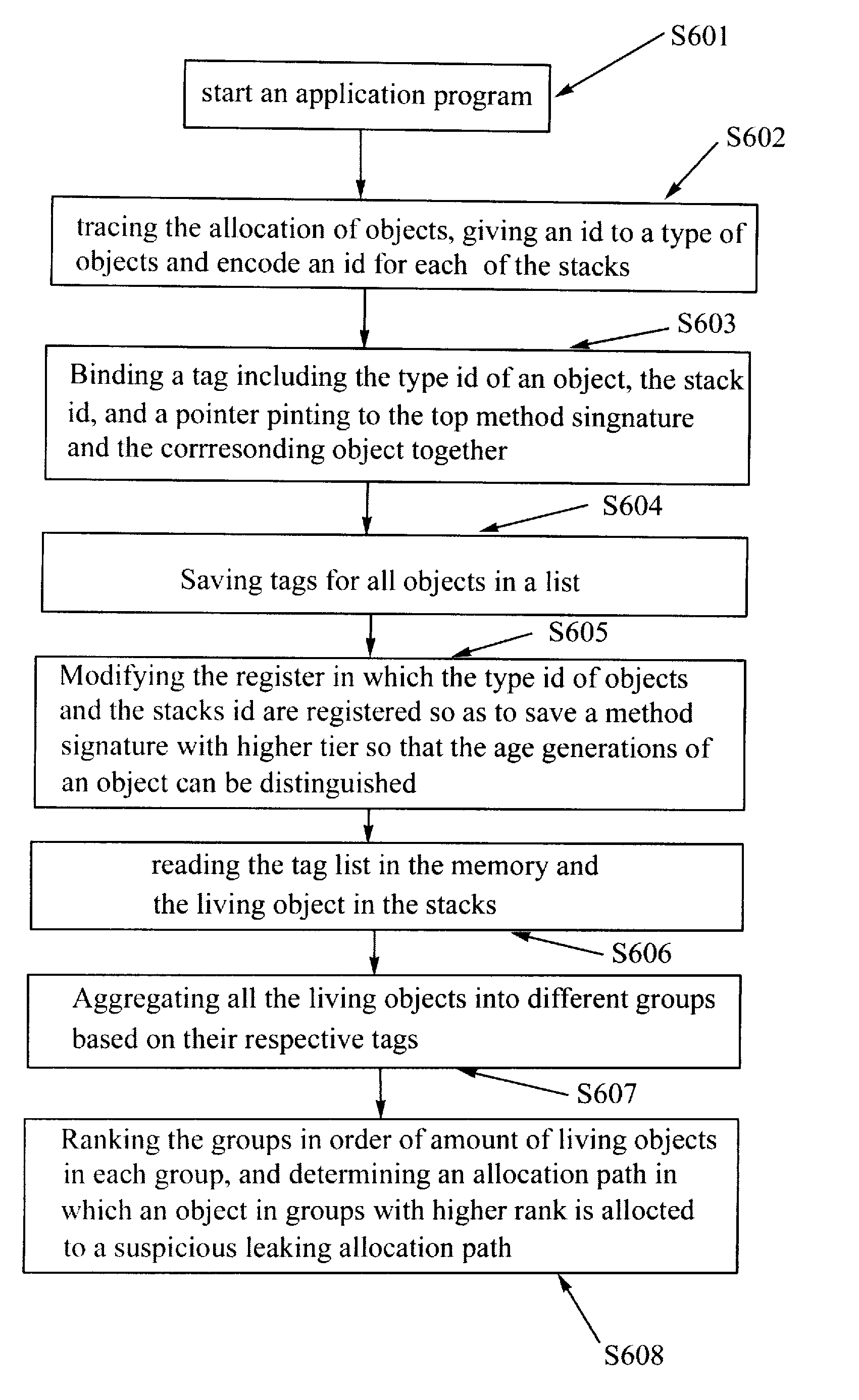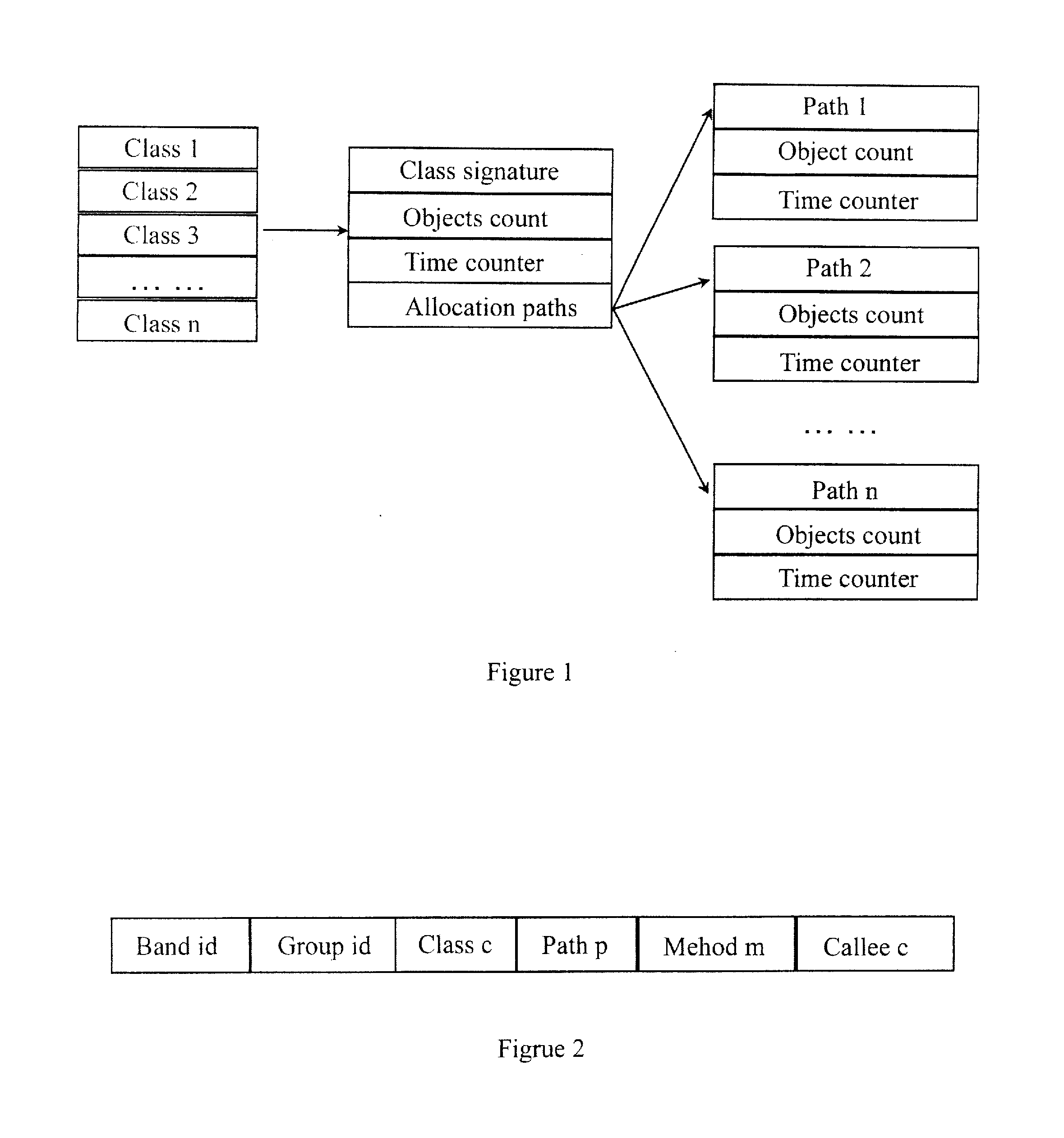If the program can not reasonably release different memories, it results in a waste of the memory resources since these memories can not be used by other programs.
However, another
disadvantage caused by the automatic
memory management is that some objects will reserve the references to the data structures in portions of the memory, but these data structures will not be used in the future execution of the application programs.
The references will prevent the automatic garbage collector from reclaiming the unused portions of the memory, and this also leads to “memory leaks”.
Although
garbage collection helps reduce the issue of “memory leaks”, the latter type of memory leaks still exist and may in some instances cause the performance of the computer to degraded and may even cause the running of the application program to consume all the memory thereby causing the computer to
crash.
Therefore, ‘memory leaks’ degrade the availability and security of the computer due to their large effect on the performance of the computer.
Typically it is not easy to diagnose the memory leaks of a
system, especially for those chronic memory leaks which occur continuously and with small volume each time.
It is rather complex to identify an apparently insignificant but potentially important increase on the heap in time.
It could be rather late when the memory leaks are found, and in this time the leaking program can caused a significant
disadvantage on the entire
system.
This is especially true for the memory leaks that start out small but continue to grow over time.
It is very difficult to identify these latent leaks, especially for the online productive system which can not endure multi-heap access, even heap dump, because these systems can not bear the execution pause due to heap traversing.
Although there exist various garbage-collection approaches and they have respective benefits, such memory leak is still a
disadvantage especially for
Java® programs (
Java is a
registered trademark of Sun Microsystems).
The existing technologies can not be used in online system, because this kind of acquisition and analysis of the heap snapshot will cause the system having a large heap capacity to pause for several seconds.
For the online system such as servers, these delays or pauses will lead to timeouts, thereby significantly influencing the performance of the online application.
Such delays and pauses are undesirable for the online system.
Also, the memory heap of large application program often has a
large capacity, and thus an attempt to frequently compare the heap snapshots offers little help for the diagnosis of application programs, because the objects that leak from the application program are not obvious.
If the existing technologies are used to perform memory leak diagnosis, the application program will be perturbed a lot due to the frequent comparing operations of the heap snapshots for the memory leak diagnosis, which will bring a negative effect on the
service quality and the programmers' experience.
Also, in some circumstances, these technologies will perturb the running application programs or systems, thereby having no practical value, especially in the
wireless circumstance.
The existing methods for diagnosing memory leaks have a limited effect on the industrial applications, because these existing methods normally recognize mostly the obvious type of memory leaks as suspicious candidates.
The analysis of reference graph needs expertise and often confuses users with respect to complex reference connections, especially a plurality of references caused by a common type.
In this case, programmers may still have difficulty knowing the reason as to why these references are produced and the reason of incurring leaks.
The
correctness of diagnosis and fix is difficult to judge and make.
In practice, taking full reference graph snapshots often and analysis on the references is far too expensive for large-scale online system.
But finding the right data structures to focus on is difficult.
When exploring the reference graphs of services (especially for large online system), issues of
noise, complexity, and scale make the analysis on the reference graphs a daunting task, especially problematic for long-running systems.
But there is a gap between the two phases, and the existing technologies do not help adequately to diagnose the memory leaks.
1. High requirements on expertise of the analyzers. The existing approaches require that the user manually distinguishes the real cause of memory leaks from within these cached objects. In general, these approaches
swamp the user with too much low-level detail about individual objects that were created, and leave the user with the difficult task of interpreting complex reference graphs in order to understand the larger context. This
interpretation process requires a lot of expertise. Even for experts, it usually takes several hours of analysis work to find the
root cause of a memory leak.
2. Perturbation caused by heap access. These techniques will in some cases perturb the running service too much to be of practical value, especially in online environments. Comparison and analysis on heap snapshots are needed after acquiring reference graphs, which can cause a system with a large heap size to pause for several seconds. As mentioned above, for servers, these delays or pauses can cause
timeout, significantly changing the behavior of the system.
3. Limited leaking analysis based on heap growth. Many existing tools find memory leaks using growth and heap differencing of heap to find the growing objects of heap. Although heap growth is a useful parameter to help judge, there are some issues with only using growth as a
heuristic to find leaks. After all, growing objects or types do not have to be leaks and leaks do not have to grow.
4. Limited leaking analysis based on reference graph. Knowing only the type of leaking objects that predominates, often a low-level type such as a ‘String’, does not help explain why the leak occurs. This is because these Strings are likely to be used in many contexts, and even may be used for multiple purposes within the same
data structure, such as a DOM document. In addition, because one low-level leaking object can simultaneously be inappropriately held by a plurality of references, it is easy to get lost quickly in analyzing the reference graph and extracting a reason for memory leakage. A single DOM object typically contains several objects, with a rich network of references among them. Without the knowledge of running program, it is difficult to know which path the reference types of leaks are created or when analyzing allocation call paths, which call site is important.
5. Limited leaking analysis based on allocation stack. Some methods can
record allocation stacks of each
type object at the same time with monitoring heap, but not all the instances of the suspicion type are leaking, so the real leaking path tends to be buried among all the stacks, and the storage and analysis of these stacks is very likely to be resource intensive. Often, leaking site can not map with the allocation site. For example,
Java Database Connectivity (JDBC) is created repetitiously by one agent class invoked by another class, and the invoked class forgets to invoke the JDBC-free function of this agent class. Here the analysis of invoker is necessary.
 Login to View More
Login to View More  Login to View More
Login to View More 


